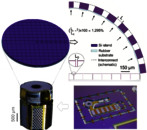Abstract Salman Shafqat
Ultra-stretchable interconnects for high-density stretchable imaging applications
Salman Shafqat1, Johan Hoefnagles1, Angel Savov2, Shivani Joshi2, Ronald Dekker2,3, Marc Geers1
1) Department of Mechanical Engineering, Eindhoven University of Technology, Eindhoven, The Netherlands, s.shafqat@tue.nl. 2) Department of Microelectronics, Delft University of Technology, Delft, The Netherlands. 3) Philips Research, Eindhoven, The Netherlands.
The quest for integrating intrinsically stiff and brittle electronics with the human body has resulted in a new and exciting field of stretchable electronics with ground breaking medical applications. Of special interest are medical imaging devices for minimally invasive procedures, such a the concept demonstrator shown in Figure 1. By rendering such a device stretchable, its functionality can be enhanced, allowing it to have variable zoom and high field of view.
The goal of this project is to achieve ultra-stretchability i.e. interconnect stretchability beyond 1000%, which is required in high stretch applications such as balloon catheters (see fig. 1). The strategy adopted here is to make the interconnects freestanding as opposed to the conventional interconnects, which are embedded in the matrix. The freestanding nature of the interconnects allows them to use extra degrees of freedom such as out of plane buckling and subsequently bending and torsion, thus allowing much increased global stretchability.
The performance and reproducibility of these free-standing structures is promising, with an elastic stretch beyond 2000% (see fig. 2) and ultimate (plastic) stretch beyond 3000%. 4-wire electrical resistance measurements show only minute (<0.3%) resistance change with stretch up to 3000%. Furthermore, the interconnects exhibit excellent performance in cyclic loading, with >10 million cycles at 1000% stretch with <1% resistance change

